Recently, PNNL of the Pacific Northwest National Laboratory of the United States released a heavy message on its official website. According to reports, PNNL developed a high-performance lithium metal battery electrolyte that can increase the service life of lithium metal batteries by more than 7 times. PNNL said The project is part of the "Battery500 consortium" program, which aims to develop a highly reliable, long-life, low-cost lithium metal battery that has a specific energy that is more than three times that of current lithium-ion batteries, resulting in a specific energy of 500 Wh/kg. the above. However, many domestic media have interpreted it as "PNNL has developed an electrolyte to increase the battery life by 7 times." It does not mention metal lithium batteries, and it is obviously misleading to readers.
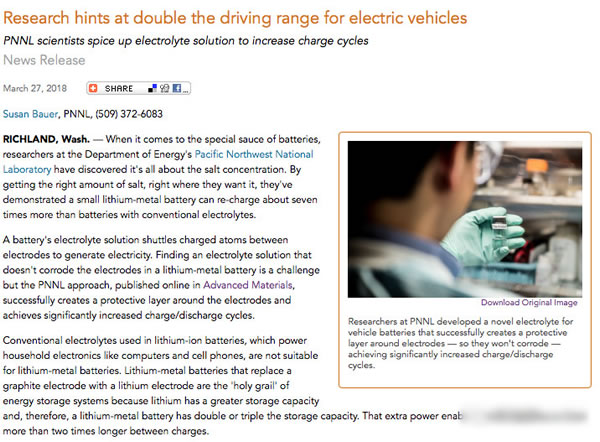
The theoretical specific capacity of the metallic lithium electrode reaches 3860mAh/g, and the potential is only -3.04V (vs. standard hydrogen electrode). It is a very ideal negative electrode material, but there is a fatal defect in the metallic lithium negative electrode - lithium metal dendrites. In order to solve the problem of lithium dendrites, many solutions have been proposed. Electrolyte optimization is a common method by adding some F-containing compounds to the electrolyte, such as (C2H5)4NF(HF)4 and fluoroethylene carbonate. Ester and the like can significantly improve the stability of the SEI film on the surface of metal Li, and high concentration of Li salt has also proved to be a very effective method, for example, high concentration of LiTFSI electrolyte can significantly inhibit the growth of lithium dendrites in Li-S batteries. . Although high-concentration electrolytes are beneficial to improve the performance of metallic Li anodes, they also have negative effects such as increased electrolyte viscosity, reduced ionic conductivity, and increased electrolyte costs.
Recently, Shuru Chen et al. of the PNNL of the Pacific Northwest National Laboratory proposed a solution for partial dilution, that is, adding a partially electrochemically stable diluent in a high-concentration electrolyte. The Li salt in the electrolyte will not dissolve. Among these diluents, the solvent in the high-concentration electrolyte can be dissolved with the diluent. Therefore, the "diluted" electrolyte forms a local high-concentration region and a local low-concentration region, thereby retaining a high concentration. In the case of the excellent characteristics of the electrolytic solution, there is a problem in solving the high concentration of the electrolytic solution. Under the guidance of this concept, Shuru Chen et al. designed an electrolyte that works stably in the negative electrode of metal Li and the positive electrode system of 4V, which can well inhibit the growth of negative Li dendrites and the cycle life of the metal Li/NCM111 battery. Increased more than 7 times, greatly improving the practicality of Li-metal batteries.
In the experiment, Shuru Chen diluted bis(2,2,2-trifluoroethyl)ether (BTFE) to 5.5M LiFSI/DMC electrolyte to obtain local dilution electrolyte with different LiFSI concentrations. The following figure shows the Coulomb efficiency of different Li/Cu batteries. It can be seen from the figure that the Coulomb efficiency of the 1.2M LiFSI/DMC electrolyte is very low, only about 9%, if the LiFSI concentration is increased to 5.5M. As a result, the battery's Coulomb efficiency immediately increased to 99.2%, indicating that a high concentration of LiFSI electrolyte has a significant effect on improving the performance of the metal Li anode. When a part of BTFE is added to the electrolyte, even if the concentration of LiFSI is reduced to 2.5M and 1.2M, the high Coulomb efficiency can still be maintained (99.5% and 99.2%, respectively). This indicates that the local dilution electrolyte is Inhibiting the growth of Li dendrite and increasing the Coulomb efficiency has a significant effect.
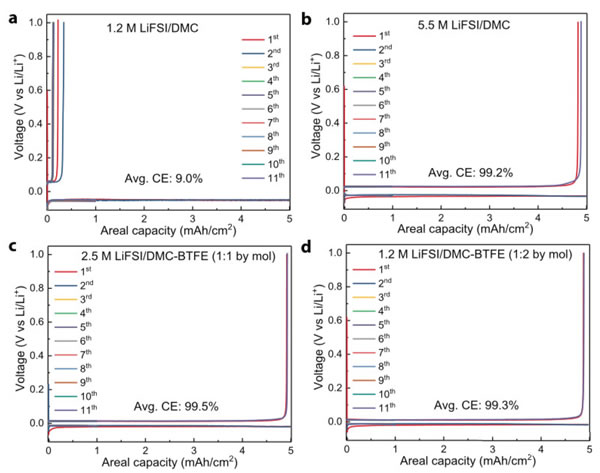
The following figure shows the SEM images of the electrodes after different electrolyte cycles (Figure a, e is the traditional LiPF6 electrolyte, Figure b, f is 1.2MLiFSI/DMC, Figure c, g is 5.5M LiFSI/DMC electrolyte, Figure d , h is 1.2M LiFSI/DMC-BTFE electrolyte. From the figure we can see that in the traditional LiPF6 electrolyte and 1.2M LiFSI electrolyte, the metallic Li shows a loose, porous state, and is associated with Li Zhi. The growth of the crystals, but in the electrode of the locally diluted electrolyte 1.2M LiFSI/DMC-BTFE, we can observe that it is mainly composed of Li particles having a diameter of about 5 μm, and there is no growth of Li dendrite. From the cross-section of these electrodes, we can also see the effect of different electrolytes on the metal Li anode. The thickness of the electrode in the 1.2M LiFSI/DMC-BTFE electrolyte is significantly lower than that of the metal Li in other electrolytes (area density). The same), this shows that in the partially diluted electrolyte Li Li anode can form a more dense structure, thereby reducing the occurrence of side reactions, improving the Coulomb efficiency and cycle life.
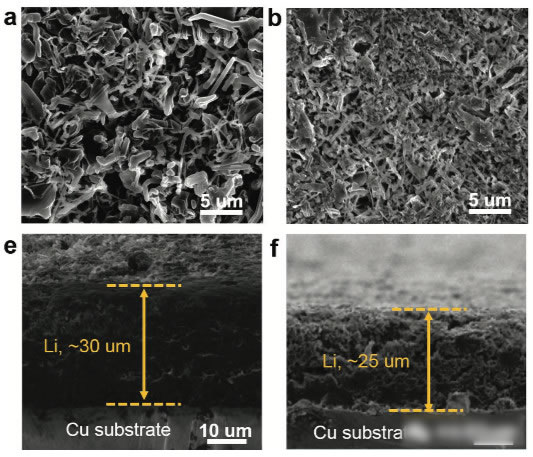
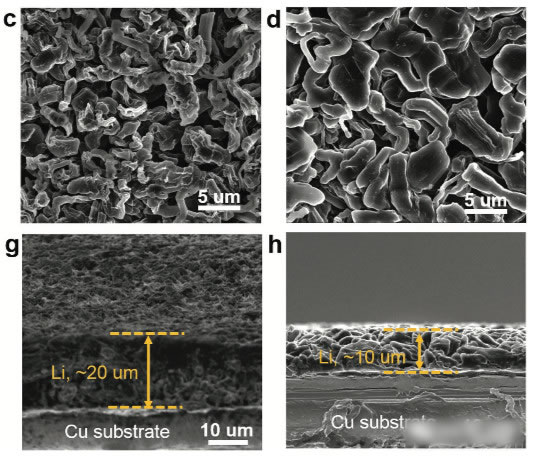
In order to verify the stability of the above electrolyte under high voltage system, Shuru Chen uses metal Li as the negative electrode and NMC111 material as the full battery made of positive electrode (2mAh/cm2, 4.3V). The following figure shows the full battery using different electrolytes. Electrochemical properties. From Fig. a, we can see that under the 1C charge-discharge rate, the battery with traditional electrolyte shows a rapid increase in polarization and a rapid decline in life (100 cycles, capacity retention rate is only 40%). Although the high concentration of 5.5M LiFSI/DMC electrolyte is helpful to improve the Coulomb efficiency of the metal Li anode, continuous polarization increase and capacity decline still occur in the cycle, and the final cycle 100 times capacity retention rate is only About 76%, this may be due to excessive Li salt concentration resulting in increased electrolyte viscosity, reduced ionic conductivity, and poor wetting. The partially diluted electrolyte showed excellent cycle performance in the cycle (cycle 300 times, capacity retention rate of up to 95%, cycle capacity retention of 700 times> 80%).
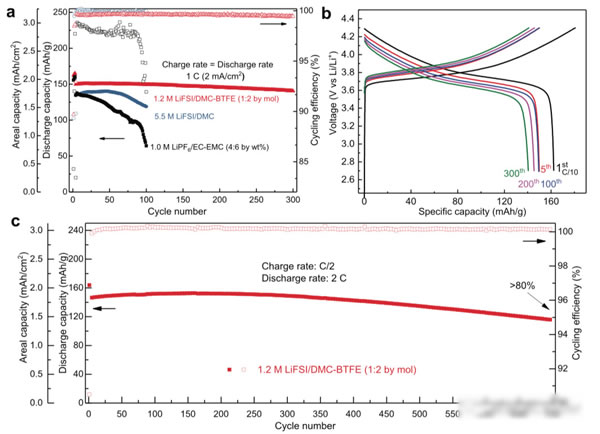
The study on the mechanism of action of the above-mentioned electrolytes found that the force between LiFSI and BTFE was significantly weaker than that between LiFSI and DMC. Therefore, LiFSI is more prone to the solvation reaction of DMC, which formed in the electrolyte. The local high concentration of LiFSI-DMC area ensures the performance of metallic Li batteries. In addition, adding a part of BTFE to a high concentration of LiFSI-DMC can increase the diffusion capacity of Li+ and reduce the diffusion capacity of FSI-, thereby increasing the rate performance of the electrolyte. The calculation of the frontier orbital theory also shows that FSI- will decompose on the negative electrode surface before DMC, resulting in an SEI film with a higher LiF content, thereby stabilizing the interface between the metal Li negative electrode and the electrolyte, and improving the cycling stability of the metallic Li battery.
ShuruChen et al. from a unique point of view, through the local dilution method, retained a local high concentration of Li salt in the low concentration of electrolyte, the advantage of doing so is not only to maintain a high concentration of Li salt in the inhibition of Li dendrite growth, Improves the advantages of Coulomb efficiency of Li batteries, avoids the disadvantages of high viscosity, low ionic conductivity, and high cost of high-concentration electrolytes, and achieves a major achievement of 700 cycles of Li/NMC batteries for stable development. It is of great significance to increase the cruising range of electric vehicles with lithium metal batteries.
Stainless Steel Door Hinges,Door Hinges with Ball Bearing, Stainless Steel Hinges, Square Edge Hinges, Radius Corner Hinges,Butt Hinges
Leader Hardware Manufacturer Limited , https://www.leaderhardwarecn.com
![<?echo $_SERVER['SERVER_NAME'];?>](/template/twentyseventeen/skin/images/header.jpg)